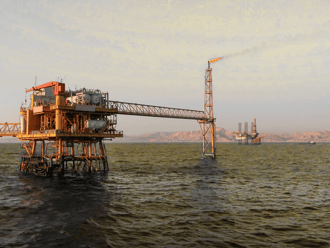May 29, 2024
The Operating Model of the Future: Executing the Vision of Digital and AI

A Conversation with LNG Canada and Accenture on Realising the Promise of Digital and AI
Senior energy leaders are seeking to balance competing priorities of the energy trilemma while running day-to-day operations. The adoption of a digital performance model (DPM) offers a sustainable way to grow business value through digitalisation.

In our latest executive webinar, we had the pleasure of spending some time with Luke Schauerte, VP of Asset at LNG Canada and Paul Siwek, Managing Director (Industry X) at Accenture to explore how companies are approaching digital transformation and why a DPM has become a cornerstone of their business strategy going forward.
Despite increased attention, is digitalisation lagging behind?
Energy leaders have been thinking about going digital for quite some time, yet many are holding back. With challenging commodity prices and capacity constraints limiting the implementation of comprehensive technology solutions, Paul highlights that the foundational elements of a value-based business strategy, foundational technology and company-wide buy-in remain important.
For LNG Canada – a greenfield LNG export terminal being built in British Columbia, Canada – digitalisation came at just the right time. Digital is often hyped out of the gate, but for companies willing to sit down and understand how digitalisation can benefit their operations, the tools experience comes together. LNG Canada sees value starting to emerge as users get on-demand insights for their daily tasks even before the facility is on stream.
Data lakes or data swamps?
For decades, the energy industry has been struggling with the data behemoth. Companies continue to reflect on the fact that existing systems landscapes lack a separation between software and data – it remains difficult to standardise solutions, which stifles innovation. One way to push past this is to realise that having data is important, but what really matters is the relationship between data and operations.
“The real priority here should be understanding what data is needed to take better decisions, have better insights, drive AI algorithms and support a digital performance model.” Luke Schauerte, VP of Asset, LNG Canada
In the last 6-12 months, LNG Canada has started understanding what data matters and the value of that data when it’s put into an environment where people can work holistically. As Luke says, that’s where money is left on the table, and that’s where companies can leverage the potential to compete in the market.
“Typical to any new tech deployment is an initial focus on data quality. As a technology provider, we’ve realised that we need a more pragmatic approach to working digitally. It’s a flip of mindset and maturation from fixing all data to focusing on the data that matters. How can I bring it together in a performance model to get the benefits and promise of digital?” Grant Christie, VP of Sales and Business Transformation, Kongsberg Digital
Pinpointing the problem
As a technology consultancy and systems integrator, Paul from Accenture encourages customers to start by asking: What problem are we trying to solve? What are the use cases where value will come from – turnaround efficiency, asset uptime, maintenance?
That’s exactly what the digital performance model promotes: finding the use cases that are most relevant for your business, and then working backwards from there to identify what systems you need, clean those, get the small wins and build momentum from there.
By rethinking our approach to work and integrating data quality into our digital architecture, we can ensure that data is placed in the right context. Then we’re already promoting high-quality decision-making at an unprecedented speed and scale.
In a nutshell, what is the digital performance model?
The digital performance model is a collection of key organisational components (processes, organisational structures, technologies and governance) that deliver faster, more transparent, higher-quality decisions and stronger business performance at scale. This is tied together in an industrial work surface that provides a digital interface where work can be done.
Organisations find value in their ability to apply this approach to low-value, high-frequency events like pump maintenance, changing between pumps during operations and filter changeouts. The micro decisions made in these daily tasks can be de-cluttered and digitalised for faster automation and to train large language models (LLMs) and AI quickly.
Decision effectiveness drives 95 percent of company performance. With the digital performance model approach, the noisy, low-value parts of business are pushed to autonomy, freeing up the organisation to see where other key decisions are getting in the way of operational performance.
Customers expect the DPM to solve specific problems
Paul from Accenture sees the DPM as a way to relieve pressure on front-line and remote workers, a way to maintain and respond to the competitiveness that the market demands. For LNG Canada, the application is hands-on.
“We have a pump with a problem – the solution is to ask John, because he's been working here 35 years. He knows that pump. This is a huge problem for scale. Our facility is in a remote location, in a high-cost country, with a complex value chain - how can we do this effectively? We need decision speed and decision quality. People need to make the right decision at the right moment.” Luke Schauerte, VP of Asset, LNG Canada
The digital performance model enables the human element to improve. Insights can be at a user’s fingertips without Powerpoint, an Excel sheet, long meetings or a hanging decision. It’s in a single, end-to-end digital environment.
Is this the future of work?
“We’ve had data forever, we have digital solutions – but how do we bring all this together so that a maintenance technician knows about their next task, how the facility is doing maintenance, how to plan for an upcoming turnaround? How do we bridge these complexities? This is what the digital performance model is solving.” Paul Siwek, Managing Director (Industry X), Accenture
On a recent site visit, an operator was blown away that our VP of Sales and Business Transformation, Grant, was familiar with the facility’s layout through the digital twin despite never having been there. That’s the power of working in a digital company that offers insights for everyone, even those working remotely. It’s not about data, or fancy 3D capabilities. It’s the ability to visualise and understand information and make high-quality decisions.
And it’s an interesting way to work. LNG Canada is especially excited about how this integrates and attracts the next generation of workers. A final story that Luke shared during the webinar: Several weeks ago, Luke met a technician out on a round. The technician was walking around looking for an exchanger and after a few seconds, came to a stop, pulled out his iPad and entered a simple search into the digital twin. Within seconds the search returned the right exchanger, including all linked documents, drawings and historical records. That’s the future of work – companies can either get onboard now or be left behind.
Author

Kongsberg Digital
Kongsberg Digital is a provider of next-generation software and digital solutions to customers within oil and gas, chemicals and offshore wind. Its Industrial Work Surface, powered by the Kognitwin® platform, is redefining how industries work with data, insight and decision-making.
Related news

14 November 2025
Industrial intelligence: Connecting the physical and digital for the future of work

24 October 2025
From isolated systems to connected workers

20 October 2025
Kongsberg Digital at ADIPEC 2025: Unveiling the Next Era of Energy Innovation

6 October 2025
Kongsberg Digital's AI-powered Industrial Work Surface